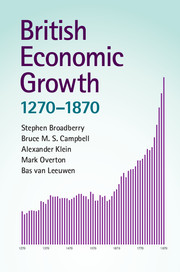Preface and acknowledgements
Published online by Cambridge University Press: 05 January 2015
Summary
Publication in 1962 of Phyllis Deane and Max Cole’s British economic growth, 1688–1959 marked a watershed in historical analysis of economic growth. Simon Kuznets and his colleagues at the National Bureau of Economic Research had already applied the relatively new techniques of national income accounting to the measurement of economic growth since the late nineteenth century, when the modern statistical age effectively began. Deane and Cole’s innovation was to extend national accounting methods to investigation of a period spanning 272 years and beginning long before statistical agencies produced long time-series of data on consistently defined variables. To achieve this they assembled their own datasets, made ingenious use of proxy measures when direct evidence was lacking, and modelled what was missing altogether. Their book is a mine of information and a model of clarity and logic.
It is fair to say that this new approach to economic history before the mid-nineteenth century was not welcomed by all economic historians, and some reviewers focused their attention on the shortcomings of the data series constructed by Deane and Cole, which they saw as undermining the credibility of the conclusions being drawn about the processes of British economic development. Other economic historians, inspired by Deane and Cole’s novel approach but sceptical of the authors’ findings, responded by refining and extending the available datasets, seeking better ways of combining them into robust estimates of national income, and ensuring that all assumptions made were empirically well grounded. After 50 years of work in this vein, Deane and Cole’s basic analysis has been fairly comprehensively revised and understanding of the processes of economic growth during the world’s first industrial revolution has been elevated to a new plane.
- Type
- Chapter
- Information
- British Economic Growth, 1270–1870 , pp. xxi - xxviiiPublisher: Cambridge University PressPrint publication year: 2015



